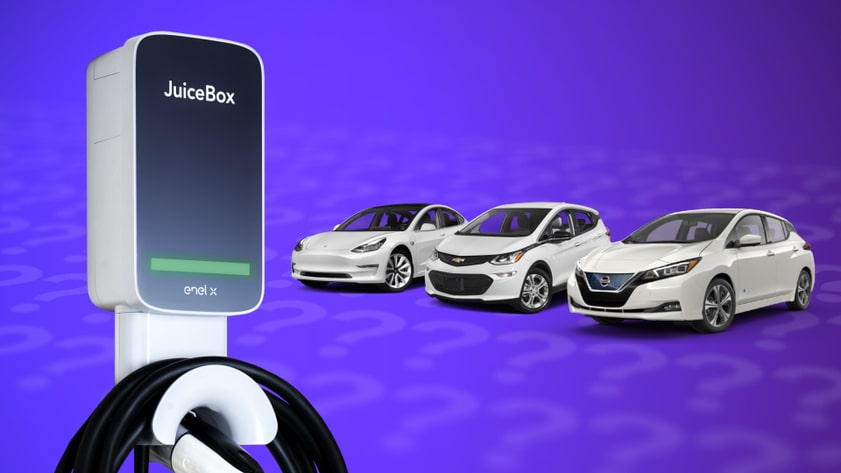How to Find the Right Home Charging Station for Your EV

Electric vehicles are quick and quiet with battery packs centered below the cabin and low to the ground, they hug the road and give the driver the feel of a modern sports car These attributes are visceral. However, one of their biggest and sometimes overlooked advantages is the convenience of refueling while at home. Crossing off a trip to the gas station, EV drivers now have one less task soaking up time and money. But now the big question is, how do new electric car owners choose the right home charging station?
While cost is an obvious consideration, most home EV chargers are competitively priced within a few dollars. So feature factors become more critical. All Level 2 charging stations use a 240-volt supply. What distinguishes the technical specifications of one charger versus another is its amperage. Just to be clear, the “charger” itself is on the electric vehicle. This article is about choosing the right “charging station,” the electrical device that hangs on the wall.
First, determine whether you need a plugin or hardwired and what size charging station is best for your Electric Vehicle
First, look at how many kilowatts your electric vehicle can accept. For example, the Nissan Leaf and Chevrolet Bolt have 6.6-kilowatt and 7.2-kilowatt onboard chargers, respectively. Tesla EVs are equipped with an 11.5-kilowatt onboard EV charger. To take advantage of the fastest possible rate for charging these vehicles, you need a home charging station with sufficient amperage to produce those kilowatt levels. This is based on the properties of electricity: volts multiplied by amps equals kilowatts. There are technical aspects to consider but here are a few basic that you need to know:
● The Nissan Leaf’s 6.6-kilowatt charger needs a 32-amp EV charger, which can add about 25 miles of range in an hour.
● The Chevy Bolt’s 7.7-kilowatt charge needs a 40-amp EV charger, which can add about 30 miles of range in an hour.
● The Tesla Model 3’s 11.5-kilowatt charger needs a 48-amp EV charger, which can add about 35 miles of range in an hour.
There’s no problem buying charging equipment with more capability than the limit of an EV. That’s because the charging station and car can reduce the power to its limit. It’s not a bad idea to future-proof your garage by buying a JuiceBox charging station with higher amperage so you have the freedom to upgrade to an electric car with faster charging. Every year the auto industry is turning out new EV models with higher charging rates.
It’s also important to consider the amperage of your home’s electrical panel. The circuit needs to be 25% higher than the charging station being used. In other words, to get the full benefit of a 40-amp charging—and ensure safety—you will need a 50-amp circuit.
Adjusting amperage can be tricky but there are some, like best-in-class home charging stations, JuiceBox, that provide an easy app-based way to adjust the amperage.
Second, determine if you need professional installation
If you see a 240-volt NEMA 14-50 receptacle in your garage then you’ve lucked out—and already have an appropriate outlet connected to a high-amperage circuit on the electrical panel. If that’s the case, a plug-in version of a JuiceBox station makes the process quick and easy. Mount the electric car charging station a foot or two away from the 14-50 receptacle—and plug it in. You’re ready to start charging. JuiceBox smart chargers also work with adapters, which are compatible with NEMA 10-30 and 14-30 outlets. Tesla cars commonly have adapters as well.
The ease of installation makes it preferable to use a plug-in electric vehicle charger and also makes the level 2 charger portable. If you move or decide to upgrade to a faster level 2 charging station, the process is as easy as unplugging one electric vehicle charging station and plugging in another one.
However, there are cases when hard-wiring might be required. Some local electrical codes will require hard-wiring but it’s mandatory for charging stations located in a carport or other location exposed to the elements. It also makes sense to hire a professional electrician for any new EV owner who doesn’t already have an existing NEMA 14-50 with sufficient amperage.
All JuiceBox charging stations are available to plug-in or as hard-wired units. Fortunately, Enel X also partners with a network of qualified electric contractors who can get the job done. The company can advise you on how to take advantage of local, regional, and federal EVSE incentives to reduce costs.
Two other common concerns for choosing a home charging station are connectivity and the length of the cable. We live in the age of “the internet of things.” The JuiceBox IoT remote controls mean that drivers can use, monitor, track, and get notifications about charging times and rates from anywhere using the mobile app. JuiceBox enables over-the-air updates to the electric vehicle charging station and paves the way for special rates from utilities, which also makes eligible for rebates and incentives.



